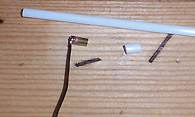| [ Q-Car Home ] [ What's New ] [ Product Listings ] [ Ordering ] [ Information ] [ About Us ] |
|
|
|
Pole Mounting
I've mentioned our local preference to use sleeve mounting for your trolley poles, where the pole simply turns in a brass sleeve set in the car roof (which I understand duplicates HO practice). The advantages are that poles can be easily exchanged or serviced, there is no back pressure on the pole from the connecting wires and that the wiring inside the carbody doesn't have to move at all, so it is far less likely to break. The poles turn very smoothly on what amounts to a brass bearing - and can turn 360 degrees freely without catching or breaking. In addition, sleeve mounts make it very easy to remove the trolley poles when packing cars away, so they don't get damaged while in the box. (Cut out the bottoms from two pill bottles and glue the open ends together for a swell pole storage unit.) 
With resin roofs, a sleeve mount is very simple and straightforward, but how about using sleeves on brass cars in place of the commonly supplied nylon bushings? Most times, we have simply dug through the styrene box for whatever size tubing works insulate the 1/8" brass tube used for our sleeve (which is drilled out slightly to clear the #2-56 mounting screws on the Q-Car poles). But I've recently been working on an MTS 170-series North Shore coach which has pretty nice detail on the pole mounts. Drilling these out to 1/4" to accept a chunky styrene insulator seemed a shame, but I couldn't find any simple alternative. 
Until I went out for a drink. Those short, thin, mixed
drink-sized straws (Figure 1) turn out to be exactly the right size to
insulate a 1/8" brass tubing. Fabrication is very straightforward, with the
sleeve length depending mostly on the roof thickness (Figure 2 ) and (Figure 3).
Allowing about 1/4" length seems to work well. Naturally, soldering the
lead wire on should be done before assembly, as the thin plastic straw isn't
very heat resistant. The mounting hole on the car roof only has to be about
We also like to cut 2-56 brass machine screws to make short threaded
rods, which we screw into the threaded hole in a Q-Car poles (the North
Shore style-B-131 is shown in (Figure 5). This photo also illustrates how
Cheap and plentiful as they are, it looks like I have enough straws left in that one box for another 2,460 or so cars - double that if they're all single-ended! Unless a few get used for libations while construction is taking place. Rule G is not always strictly observed here at the 96th Street shops. billbb |
| [ Back to Top ][ Q-Car Co. - Home ][ contact@qcarcompany.com ] | Page Last Modified: 23-Mar-24 3:58 PM |